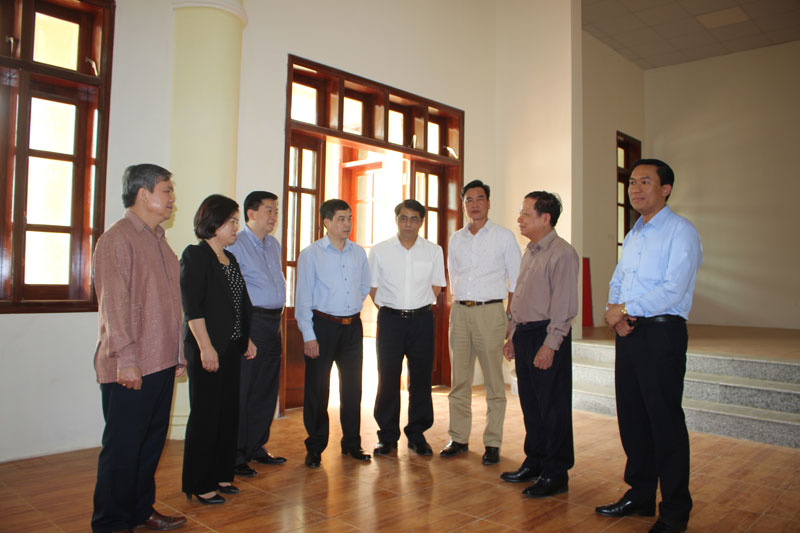
(HBO) – Bui Van Tinh, member of the Party Central Committee and Secretary of the provincial Party Committee of Hoa Binh province, has held a working session with the Party Committee and the People’s Committee of Xuan Phong commune (Cao Phong district) about the merger of hamlets and villages in accordance with Decision No.1084/QD-UBND on the project "Piloting merger and streamlining of hamlets and residential areas in Hoa Binh province”.

Leader of
Xuan Phong commune (Cao Phong district) reported the merger of hamlets to the
Secretary of the provincial Party Committee and leaders of departments and
agencies./.
Xuan Phong is one of the two communes chosen to carry out the
project. After studying guideline documents and State regulations on population
and coverage, the Party Committee and the People’s Committee of Xuan Phong
commune decided to merge Ru 1, Ru 2, Ru 3 hamlets into Ru Giua hamlet.
Accordingly, after the merger, Xuan Phong commune will have a total of 10
hamlets instead of 12. In the near future, the commune plans to continue
mergers to reduce the number of hamlets to 6. The district’s Party Committee,
administration and steering committee will acquire more experience to continue
directing the project.
Concluding the working session, Secretary of the provincial Party Committee Bui
Van Tinh highlighted several key tasks in the near future, including soon
reviewing the project to learn from lessons and issuing new policies to spread
the project across the province, issuing guidelines to promptly settle issues
regarding State apparatus, policies and operating expenses of hamlets and
villages. After mergers, the State will ensure the most favourable conditions
for administrative procedures and effective use of public assets.
He asked for issuing criteria to establish new hamlets such as population,
cultural and religious similarities; classifying hamlets to ensure fair
allowances for part-time cadres, taking flexible approach to arranging
apparatus of hamlets and villages, well performing personnel policy, including
incumbent and retired personnel after mergers, offering guidelines on building
regulations for newly-merged hamlets and villages to uphold solidarity and
close-knit ties in residential areas, thus ensuring local political security
and social safety and order. The district Party Committee, People’s Committee
and administrations of commune will continue joining efforts to ensure
activities of hamlets and villages after mergers./.
Hoa Binh province is undergoing a dynamic transformation amid Vietnam’s national digital transition. Building on Poliburo’s Resolution No. 57-NQ/TW on breakthroughs in science, technology, innovation, and national digital transformation, the province has rolled out a wide range of practical action plans. A standout initiative is the "Digital Literacy for All” movement, an effort to ensure that no one is left behind in the digital era.
Hoa Binh province is undergoing a dynamic transformation in the wake of the national digital transformation movement. Building on Resolution No. 57-NQ/TW of the Politburo on breakthroughs in science, technology, innovation, and national digital transformation, the province has implemented a wide range of practical action plans. A standout initiative is the "Digital Literacy for All” movement ambitious effort to ensure that no one is left behind in the digital age.
With a spirit of unity and proactive problem-solving, the Party Committee, the government and the people of Dong Lai Commune (Tan Lac District) have made great strides in implementing the resolutions of the 24th Party Congress of the commune for the 2020 - 2025 term. Focusing on leadership and practical actions, the commune has brought the Party’s resolutions into daily life, creating strong impacts and pushing the local development forward.
Amid the nationwide push for digital transformation, young people in Hoa Binh Province are stepping up as dynamic pioneers, applying technology to enhance Youth Union operations and expand the reach of youth-led initiatives. Through creativity and adaptability, Youth Union organizations at all levels have introduced a series of practical solutions, contributing to modern governance and community development.
In recent years, An Nghia commune, located in Lac Son district, has stepped up administrative reform, focusing on improving the quality and efficiency of its single-window service unit for receiving and processing administrative procedures. These improvements have helped create favourable conditions for local residents and organisations to handle administrative procedures, contributing to the commune’s broader socio-economic development.
The Prime Minister-approved master plan to develop the multi-use value of forests ecosystems through 2030, with a vision to 2050, aims to improve the management and sustainable use of forest resources, create jobs, increase incomes, and improve the living standards of ethnic minorities, people in mountainous and remote areas, forest workers and those living near forests.



